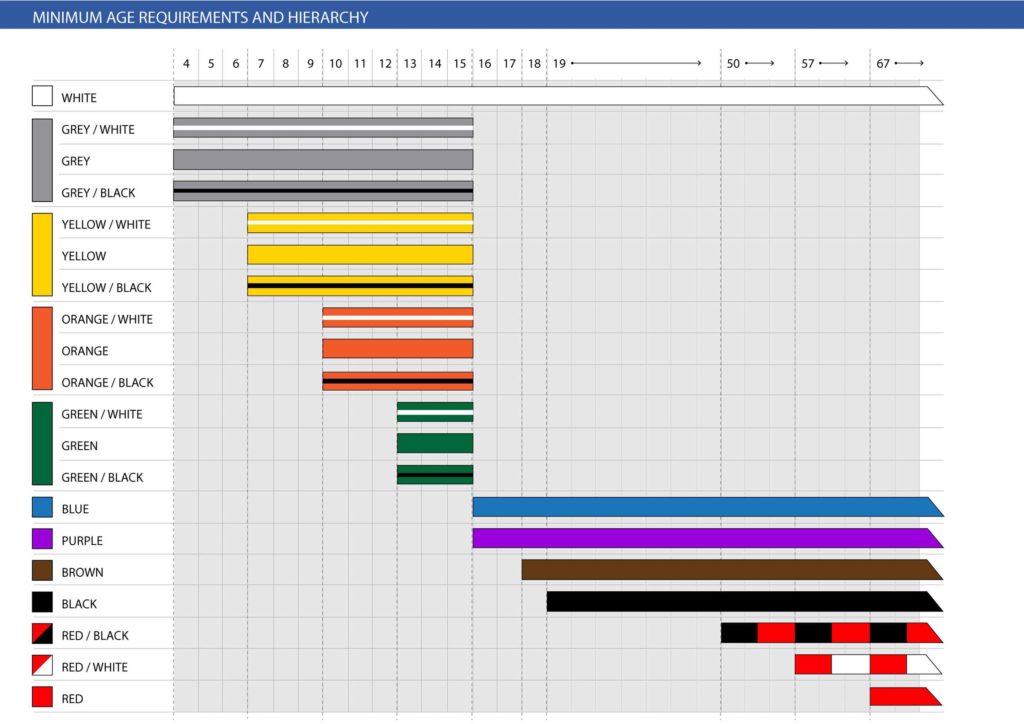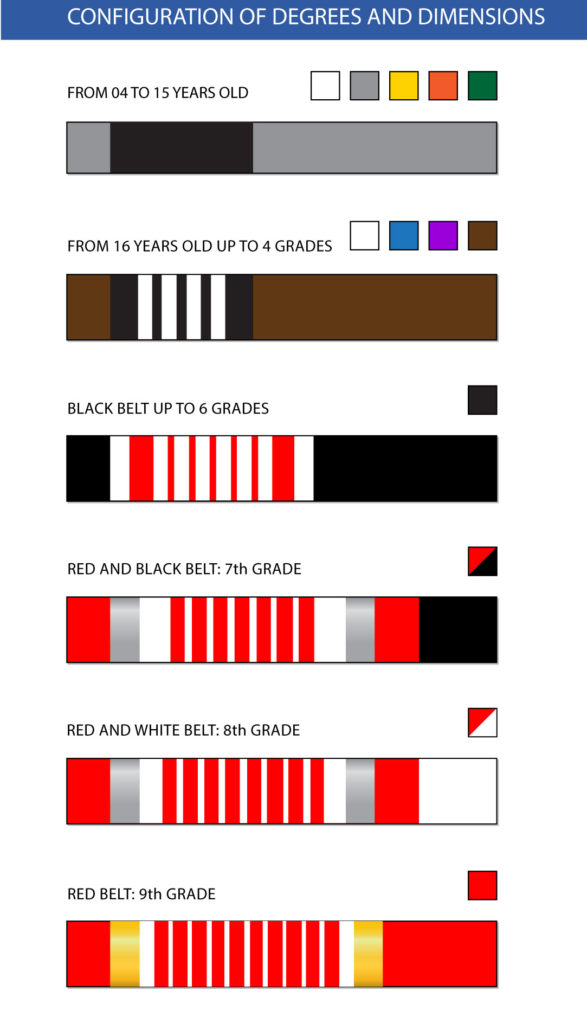 There’s profound symbolism embedded in every aspect of mat traditions, including the attire. The original names of the training Gi, from the straightforward “keikogi” (meaning “training clothes”) to the more philosophically nuanced “dogi” (“the cloth of the path”), reflect the rich heritage of Jiu Jitsu belts.
There’s profound symbolism embedded in every aspect of mat traditions, including the attire. The original names of the training Gi, from the straightforward “keikogi” (meaning “training clothes”) to the more philosophically nuanced “dogi” (“the cloth of the path”), reflect the rich heritage of Jiu Jitsu belts.
But there’s probably no item on the Jiu Jitsu practitioner’s bag that carries more meaning than its belt, also called “obi”. Much more than just a strap of fabric, used to keep the training Gi in place during fight, since the early days, the belt was deeply connected to the warrior’s energy, his spirit and history.
With the samurai’s sword put aside, carrying with them the battle marks that branded one as a true warrior, the belt – with all its rips, fades and, yes, even its dirt – started to represent the fighter’s victories and defeats. And, more importantly, the path of his learning.
In this article, we’ll discover what are the Jiu Jitsu belts, what each color represents and what it takes for a practitioner to progress in their scale.
The belt colors scales
While the belt’s design and spiritual meaning remained pretty much the same for the last thousand years, the use of different colors as a measure of fighting ability is a relatively recent innovation, dating back only a century.
This tradition started around the 1880th, when Jigoro Kano (founder of Kodokan school of Judo) decided to differentiate his disciples using the belt’s color. The beginners were wearing the white belt and the initiated, more skillful students, marked with the black belt.
The modern Jiu Jitsu, however, like many other Japanese martial arts, uses two ranking scales. There’s the “kyu”, the well known, colorful graduation of belts that goes from white to black. And the “dan”, which are the graduations granted to the fighters that already reached the black belt. In this article, we’ll talk about the kyo system.
While it may vary from school to school, in general, Brazilian Jiu Jitsu mesures the progress of its fighters with 12 different belt colors, each of them containing many degrees. Some of them are limited by the practitioners’ age or determined by time of training. Others are achieved only through trials of skill and through merit.
According to Fernando Halfeld, School of Jiu Jitsu head coach, “unlike other MA, the belt progression in BJJ can take a long time. Is something that’s achieved through frequency, endurance and consistency. Some fighters take one year, others take three to get a new belt”.
There’s some ways to speed up this process. Joining in competitions, for instance, can shorten the period between one belt progression and another. But, in general, time and effort is all it takes to go from a white to black.Passing through all the 8 belts for adult practitioners with an additional 4 specific belts to children until they reach the age of 16.
Discover the origins of Brazilian Jiu Jitsu.

The belts and their meaning
WHITE BELT
Beginners of all ages. Minimum of one year of training before progressing.
Much like raw fabric, this belt color represents the purity before unknown challenges. It serves as a reminder for the students to keep their minds clear and open to new knowledge.
But make no mistake: the white belt is far from meaning a blank slate. The first step through the path of Jiu Jitsu was already taken, when the student decided to enter the mat.
GREY BELT
Students between 04 and 07 years old.
What happens when you roll on the ground, time after time, with white clothes? That’s right, you get a little grimy.
That’s what this belt color represents: while the young student still has a long way to go, it already faced some challenges and gained knowledge on this dusty road.
YELLOW BELT
Students between 07 and 15 years old.
Like the morning sunlight, the yellow belt represents the beginning of a new day, when the student “wakes up” as a fighter. And, like every new day, it comes with a promise of entirely new challenges, with victories and defeats, and lots of learning.
ORANGE BELT
Students between 10 and 15 years old.
While the morning yellow sun is full with novelties, the noon’s orange light can be a little more demanding. This belt color represents the young fighter’s progress, but is also supposed to remind the student of the increasing responsibilities and expectations.
GREEN BELT
Students between 13 and 16 years old.
In this level, the fighter is regarded as a young, growing tree. It has already established its roots and mastered the basic moves of Jiu Jitsu. Now, it’s considered ready for more advanced knowledge and capable of handling its own inner forest.

BLUE BELT
Students above 16 years old. Minimum of two years of training before progressing.
This belt represents the color of the welkin to where all those growing trees aim to reach. It represents the destiny of the straight, rightful path of the fighter, that must be trodden with wisdom and humility.
PURPLE BELT
Students above 16 years old. Minimum of one and a half years of training before progressing.
This belt marks the transition between the apprentice and the “master in training” level of the student. Going forward, the fighter is expected to serve as an example for the other students and to help in their learning.
For the fighter to reach the black belt it’s only a matter of maintaining the wisdom and stamina shown so far.

BROWN BELT
Students above 17 years old. Minimum of one year of training before progressing.
Still and strong as earth itself. The student at this level has already been hardened by the path of Jiu Jitsu, and its knowledge is setted in firm ground, never to be forgotten.
BLACK BELT
Students above 19 years old.
The student becomes a teacher. This belt color celebrates the consolidation of the warrior’s knowledge and the physical ability, its strength and discipline, its humility and resiliency. The challenges of the path have been overcome. Now, the fighter can start building his legacy through his own students.
Now you know all about the evolution of belts on the mat, how about becoming a Brazilian Jiu Jitsu fighter? Schedule a free trial.
Can you skip belts in BJJ?
By now, you might be thinking that the process of progressing through belts until you reach black is too long. And if that’s the case, you are probably wondering: “is it possible to skip belts?”.
The answer is no.
As already mentioned throughout this post, the only way to get a new belt in an accelerated manner is through entering championships and showing good performance and displaying good values and discipline. But even so you need a minimum amount of time with your belt before progressing again.
What are the belts of these UFC champions?
1. Conor Mcgregor
‘The Notorious’ is currently a proud holder of a brown belt in Brazilian Jiu-Jitsu. McGregor has even competed in grappling tournaments in the past, graduating to a brown belt under his coach, John Kavanagh, back in 2014, after his win over Dustin Poirier.
2. Khabib Nurmagomedov
The Russian Khabib Nurmagomedov displays with humility his white belt, stealing the scene on the octagon and attracting even more sympathy and admiration from the public. The fighter, who is a black belt in Judo and also a two-time World Sambo Champion, surprised the world by posting a picture with his white Jiu Jitsu belt tied around his waist. Showing everyone that, even for a great fighter like him, there will always be chances to learn new things.
3. Royce Gracie
Royce Gracie is a 6th degree black belt with an impressive record in Brazilian Jiu Jitsu, as well as in his winning career in “Vale-tudo”, being three times UFC champion and also winning in Bellator, Pride, and K-1 MMA (Japanese events).
Is Black belt the end?
A black belt is, without a doubt, everyone’s goal!
But know that there are belts subsequent to it. However, these belts (or rather, “graduations” or “degrees”) are granted as an honor to those who have been graduated from black belt for a long time and keep on the path of learning, now as teachers or competitors.
Are you a white belt and ashamed of your rank?
Get inspired by Khabib: be humble and seek evolution.
As we mentioned before in this article, Jiu Jitsu is not a race, but a path towards learning and self-improvement. Each one of us begins this journey at our own time and our progress is determined by our own pace.
Don’t be ashamed of your white belt! Instead of hiding your graduation, choose to seek technical knowledge, so that you become a thick skinned white belt and consequently graduate faster!
Seek daily knowledge and evolution! Only then will you thrive in the sport and overcome the difficulties on the mat!
